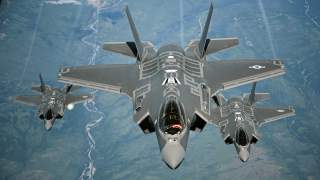China Wants to Make the F-22 and F-35 Stealth Fighters as Obsolete as Battleships
How?
As the paper describes, quantum radar uses a novel concept in physics, which scientist are only just starting to understand. “Quantum physics says that if you create a pair of entangled photons by splitting the original photon with a crystal, a change to one entangled photon will immediately affect its twin, regardless of the distance between them,” the paper states. “A quantum radar, generating a large number of entangled photon pairs and shooting one twin into the air, would be capable of receiving critical information about a target, including its shape, location, speed, temperature and even the chemical composition of its paint, from returning photons.”
Could Beijing’s quantum radar technology render stealth aircraft obsolete?
While theoretically, if such a radar existed, it would be able to detect and track stealth aircraft with impunity, but it is unclear if China truly mastered such technology. The Chinese defense industry has claimed a breakthrough in mastering quantum radar technology, but Western defense industry officials said that such a system is not likely to exist outside a laboratory. Even then, the quantum radars would be difficult to build and test reliably even in a lab environment. Indeed, it is likely that networked low-frequency radars—which can also detect and track fighter-sized stealth aircraft—are more likely to be a more pragmatic development.
Last year, China Electronics Technology Group Corporation (CETC) announced it had tested such a radar at ranges of roughly 60 miles. While 60 miles is not particularly huge feat, the fact that such a radar would be able to provide a weapons quality track on a stealth aircraft at those distances is impressive.
Most radars operating in the fire-control bands such X or Ku are only able to paint a low observable aircraft at much shorter ranges. And indeed, Chinese sources claim that the range for an operational version of the quantum radar is likely to be much greater. “The figure in declassified documents is usually a tuned-down version of the real [performance],” a Chinese military researcher told the South China Morning Post last year.
As the paper describes, quantum radar uses a novel concept in physics, which scientist are only just starting to understand. “Quantum physics says that if you create a pair of entangled photons by splitting the original photon with a crystal, a change to one entangled photon will immediately affect its twin, regardless of the distance between them,” the paper states. “A quantum radar, generating a large number of entangled photon pairs and shooting one twin into the air, would be capable of receiving critical information about a target, including its shape, location, speed, temperature and even the chemical composition of its paint, from returning photons.”
However, even Chinese researchers are skeptical about the CETC development. Nanjing University physicist Ma Xiaosong told the South China Morning Post that in a quantum radar, photons have to certain quantum states—such as upward or downward spin to remain entangled. However, the quantum states could be disrupted—resulting in “decoherence.” Decoherence is a potential limiting factor to the maximum effective range of an operational quantum radar.
According to the South China Morning Post, CETC has made a breakthrough in single-photon detectors. Indeed, once the technology matures, the Chinese believe that it could have a wide range of applications for quantum radar technology.
The fact that Beijing is working hard to counter stealth technology should not come as a surprise.
Dave Majumdar is the defense editor for The National Interest. You can follow him on Twitter: @davemajumdar.
This first appeared in February.

